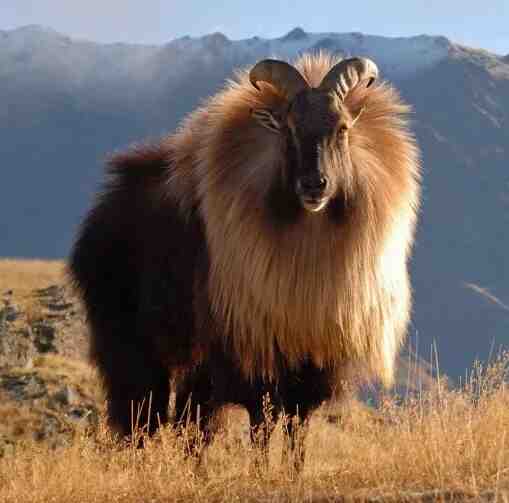Hemitragus jemlahicus
IUCN
LCBasic Information
Scientific classification
- name:Hemitragus jemlahicus
- Scientific Name:Hemitragus jemlahicus,Himalayan Tahr,Long-wool sheep, Tahr sheep
- Outline:Ungulata
- Family:Artiodactyla Ruminantia Bovidae Caprinae Tahr
Vital signs
- length:120-140cm
- Weight:80-100kg
- lifetime:16-18 years, lifespan is 21.9 years
Feature
It was discovered in my country in 1974.
Distribution and Habitat
In China, it is only distributed in some valleys on the southern slope of the Himalayas (from Zhangmu to Jilong County). In addition to China, the native species are distributed in Bhutan, Sikkim, Nepal, Punjab in India and even Kashmir.
It mainly lives on the southern slope of the Himalayas at an altitude of 3,000 to 4,000 meters. It often moves in rugged bare rock mountains and forest edges, and is adapted to the cold and rainy climate. At night, it hides in high mountain shrubs or rocky areas.
Appearance
The Himalayan Tahr sheep is stout, with a body length of 120-140cm, a shoulder height of 84-101cm, and a male weight of 80-100kg. The entire head is narrow and long, and the male has no long beard under the chin, and the face and snout are bald and hairless; the female has gray-brown horns, but the male horns are thicker than the female horns, and the two horns are in an inverted "human" shape when viewed from the front. The horns are short and flattened, not curved, and the distance between the bases is relatively close. There are wrinkles on the horn clips. The length is about 30cm, and the highest record is 4cm; there is no beard under the jaw, the tail is short, and the belly is exposed. Female sheep are smaller than male sheep. The whole body is coarse and hard, dark gray-brown or brown. The hair on the neck, shoulders and buttocks of male sheep can be as long as 12-18cm.
The Himalayan Tahr sheep has long and dense hair on its shoulders and neck, which hangs down to t
Details
The Himalayan Tahr sheep has three subspecies. In the first half of 1974, Cai Guiquan, Wang Zuxiang from the Qinghai Provincial Institute of Biology and Cao Junhe from the Beijing Natural History Museum first discovered the Himalayan Tahr sheep in the Quxiang area of the Boqu River Valley in the Tibet Autonomous Region. It has been listed as a national first-class protected animal.

Himalayan Tahr sheep usually live alone or in small groups. They live on hillsides with trees. They forage in the early morning and evening, eating both grass and leaves, almost any plant. They find sheltered places to rest during the day. They move together in groups, sometimes up to 30-40. They are alert and difficult to approach. It is especially difficult to approach them when walking up the slope, because there are always sheep acting as guards in the group, paying close attention to any signs of danger around. Old males form small groups in summer and live in the most rugged and dangerous places. In winter, they return to the large group and spend the winter together. Tahr sheep need to drink water every day. This animal is an agile climber. It lives on cliffs and feeds on grass and shrubs in rock piles. Himalayan Tahr sheep usually go down the mountain to find drinking pools in the valley.
Himalayan Tahr sheep mainly feed on herbs and also eat young leaves of shrubs. Generally, they mate in late winter and early spring, with a gestation period of 6 to 7 months. They give birth in June, with one baby per litter, and sometimes two babies. They belong to the marginal areas of my country and are rare in number.
The Himalayan Tahr sheep has a strong smell of meat and has little economic value, so poaching is less common than other sheep. However, due to its small range and small number, there are only 500 left.
Listed in the IUCN Red List as Near Threatened (NT).
Listed in the first level of the "List of National Key Protected Wildlife in China".








